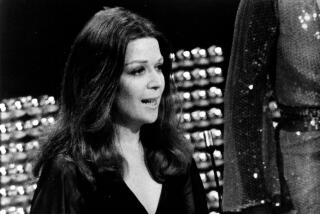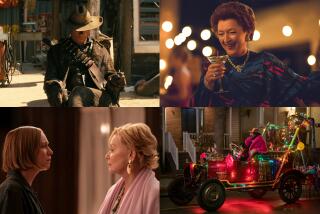A Tale of Two Miniseries--One Good, One Bad : Television: There are striking parallels between Dickens’ ‘Tale of Two Cities’ and Judith Krantz’s ‘Till We Meet Again,’ but quality is not one of them.
Who says television lacks diversity?
This weekend brings the best of timeslots and the worst of timeslots, the Sunday of wisdom and the Sunday of foolishness, the network of belief and the network of incredulity, the miniseries of light and the miniseries of darkness.
On Sunday, we will have everything before us (Charles Dickens’ “A Tale of Two Cities” on PBS) and we will have nothing before us (Judith Krantz’s “Till We Meet Again” on CBS).
Yet there are striking parallels in these two works of historical fiction.
Just as Dickens’ two cities are Paris and London, Krantz’s story is set in France and Britain, in addition to California. Both also interweave romance and violence, and both are written by famous authors (Dickens, as it turned out, writing for the ages, and Krantz, the Bob’s Big Boy of contemporary literature). What’s more, the “wilderness of ruin, misery and oppression” that Dickens applies to pre-revolutionary France also characterizes “Till We Meet Again,” which, as a bonus, is also a wilderness of mush.
If Dickens has the overwhelming numerical edge in heartless French aristocrats and vengeance-blinded revolutionaries, Krantz gives us her own epic French cad in Bruno the snot, whose actions in “Till We Meet Again” echo the credo of the Marquis St. Evremonde in “Tale of Two Cities”: “Repression is the only lasting philosophy.” More about Bruno shortly.
But first (at 9 p.m. on Channels 28 and 15 and 8 p.m. on Channels 50 and 24), this new adaptation of “A Tale of Two Cities,” produced as a four-parter by Britain’s Granada Television and the French Dune and Antenne 2 to commemorate last July’s 200th anniversary of the French Revolution. The stage here is “Masterpiece Theatre.”
Channel 28 is airing Parts 1 and 2 back to back and--to accommodate a Nov. 26 concert telecast live by San Francisco’s KQED to benefit Bay Area earthquake victims--skipping a week before returning with the concluding two parts on Dec. 3.
To capsulize “A Tale of Two Cities”:
As the rotting nobility is about to be toppled and annihilated by the long-suffering French people, Charles Darnay (Xavier Deluc) and brilliant-but-degenerate London lawyer Sidney Carton (James Wilby) fall in love with the luminous Lucie Manette (Serena Gordon), whose elderly physician father (Jean-Pierre Aumont) has just been freed from the Bastille after being locked away for 18 years. Lucie marries Darnay, an idealistic French aristocrat who has renounced his family name of St. Evremonde out of shame, and lives in London.
The revolution erupts, and aristocrats are paraded to the guillotine en masse. Drawn back to Paris, Darnay is unjustly held accountable for his family’s crimes and ordered executed. Now it’s time for Carton to rev up, as he heroically fulfills his vow to Lucie to give his life “for you--or anyone you love.”
There’s lots to like here. Adapted for TV by Arthur Hopcraft and directed by Philippe Monnier, “A Tale of Two Cities” is grandly staged and a nice way to spend an evening. The climactic last half hour--in which Carton gives meaning to his life by sacrificing it--is beautifully done. Moreover, you have to admire Hopcraft’s humanized Madame Defarge (Kathie Kriegel), who remains pitiless without being mindlessly maniacal. Most of the major players are fine, but it’s Jean-Marc Bory who almost steals the first hour as Darnay’s doomed uncle, the unredeemably cruel marquis.
Unfortunately, there are visible seams that distract. The editing is at times disjointed, the romance sequences just a little bit static and Aumont’s dottering old Dr. Manette too broad to be credible. This “A Tale of Two Cities” nicely captures the emotion of Carton’s rebirth. What’s missing is passion, a convincing portrayal of the revolution’s blind fury that stained the streets with blood.
Passion--of another sort--is available on CBS Sunday. Depending on your point of view, “Till We Meet Again” (9 p.m. on Channels 2 and 8, with Part 2 airing at 8 p.m. Tuesday) is either too bad to watch or too bad to ignore. Television has rarely been funnier.
This is no less than a festival of dumbness as it traces the tumultuous lives of a mother and two daughters, and, of course, the men they love.
We meet Eve (Lucy Gutteridge) in 1913 as a rebellious 17-year-old French girl who runs away to the big city and becomes a dance hall singer. Her friend tells her: “Soon you will conquer Paris.” Two years later, she is en route to entertain French troops on the Western Front when she is forced to take refuge in a barn from German shells. Then the door flies open, and it’s dashing Capt. Paul de Lancel (Michael York)--heir to a French champagne dynasty--and his troops.
The soldiers sit down. Eve sings to them. The soldiers fall asleep. A sign. Even the violins sound bored.
Directed by Charles Jarrott and adapted by Andrew Paul Martin, “Till We Meet Again” is a Rolodex of cliches--one comical, badly acted scene after another. Paul’s first wife shoots herself in the head, and there’s no blood. Later, two hours into his first date with Eve, Paul proposes and she accepts. It’s that kind of show.
Their two daughters go in different directions, Delphine (Mia Sara) as an actress in Paris, and Freddy (Courteney Cox) as a pilot in the United States and in Britain during World War II.
The family black sheep is Paul’s son by his first marriage, Bruno the snot (Hugh Grant), a sniffy, malicious, power-mad snob who despises his own family, is thrilled when the Germans occupy France and later commits unspeakable acts. Do you hear, UNSPEAKABLE!!! At least Bruno the snot gets your attention.
Although spanning 43 years and several nationalities, “Till We Meet Again” has no sense of period or texture: Not only is Eve’s face as vacant as a cantaloupe, she doesn’t age except for a few gray hairs. Meanwhile, Paul and Eve are French, yet he speaks English with a British accent and she with a cultured American accent. Bruno the snot only briefly budges from France, yet oozes Oxford. This is especially confusing when the British-sounding French characters are in Britain, or California.
Of course, the accent hasn’t been invented that could improve this dialogue. Here is French director Armand Sadowski (Charles Shaughnessy) rejecting Delphine’s offer of a kiss: “No. First I must undress you, button . . . by . . . button.” And here’s that big lug Jock Hampton (Bruce Boxleitner) all ga-ga over Freddy: “You beautiful, wonderful handful!” Your eyes fill with tears.
A tale of two miniseries. In choosing one, remember: It is a far, far better thing that Charles Dickens does, than Judith Krantz has ever done.
More to Read
The complete guide to home viewing
Get Screen Gab for everything about the TV shows and streaming movies everyone’s talking about.
You may occasionally receive promotional content from the Los Angeles Times.






